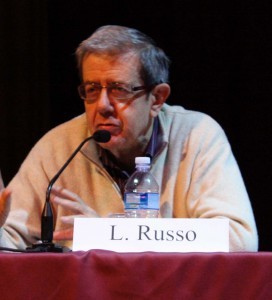Hipparchus
Tsikritsis, Minas
Minas Tsikritsis, a native of Crete, is a Professor of Computer Science and noted Researcher of Aegean Scripts. Included in his work is his claim to have deciphered Linear A and the Phaistos Disk, one side of which appears to be a form of sea shanty. Gavin Menzies quotes[780.319] Tsikritsis’ belief that the Minoans had mathematical knowledge equal, if not superior, to that of the Babylonians and Egyptians.
However, this claim has been seriously challenged by a recent study of a 3,700-year-old Babylonian tablet known as Plimpton 322. The tablet was discovered around a century ago in what is now southern Iraq. Australian scientists from the University of New South Wales, Sydney have now demonstrated that the tablet is the world’s oldest and most accurate trigonometric table, predating the Greek astronomer Hipparchus by over a millennium(b). These claims have generated some considerable debate (c).
Additionally, based on an analysis of Plutarch’s “On the Apparent Face in the Orb of the Moon,” Tsikritsis believes that the Greeks had contact with North America, at least as far back as 86 AD!(a) *Some time later he expanded on the idea in a paper published on the Researchgate website(d).*
(b) https://www.nytimes.com/2017/08/29/science/trigonometry-babylonian-tablet.html
(c) https://blogs.scientificamerican.com/roots-of-unity/dont-fall-for-babylonian-trigonometry-hype/
*(d) https://www.researchgate.net/publication/321319687/download*
Russo, Lucio
Lucio Russo (1944- ) is an Italian mathematician, physicist and science historian. In his 2013 offering L’ America dimenticata[1060] (The Forgotten America) he bravely suggests that America was discovered by * the Phoenicians or the Carthaginians. He also claims that the longitude of the Lesser Antillies (known as the Isles of the Blest) was known precisely to Hipparchus (190-120BC), but that Ptolemy (90-168AD) later identified the Isles of the Blest with the Canaries and made a catastrophic error when he reduced the circumference of the Earth to 180,000 stadia from the nearly exact figure of 252,000 stadia calculated by Eratosthenes centuries earlier.
* the Phoenicians or the Carthaginians. He also claims that the longitude of the Lesser Antillies (known as the Isles of the Blest) was known precisely to Hipparchus (190-120BC), but that Ptolemy (90-168AD) later identified the Isles of the Blest with the Canaries and made a catastrophic error when he reduced the circumference of the Earth to 180,000 stadia from the nearly exact figure of 252,000 stadia calculated by Eratosthenes centuries earlier.
Having unravelled Ptolemy’s error Russo was then able to locate the position of Thule on the coast of Greenland(a). Jason Colavito had a few critical words to offer regarding Russo’s theory(b).
>Nevertheless, in an interview, Russo defends the central thesis of his L’ America dimenticata regarding early transatlantic travel. In the link below(c) which offers an English translation of the interview, a number of excerpts from his book are also added.<
(a) https://en.wikipedia.org/wiki/Lucio_Russo
(b) https://www.jasoncolavito.com/blog/italian-mathematician-ancient-greeks-discovered-America
